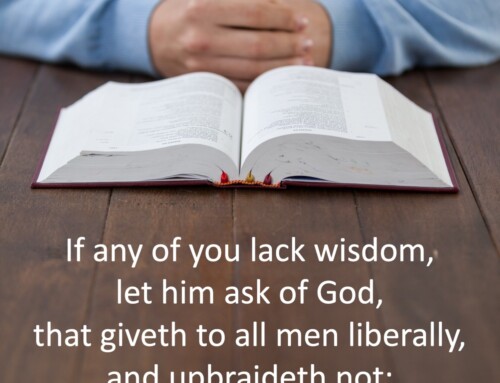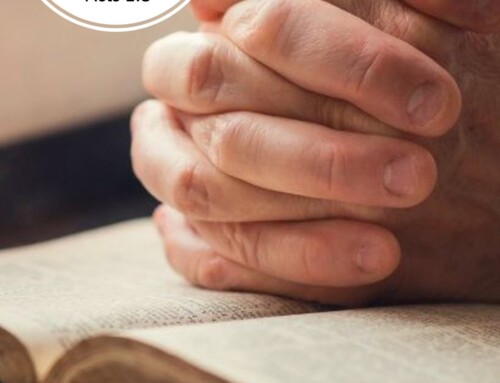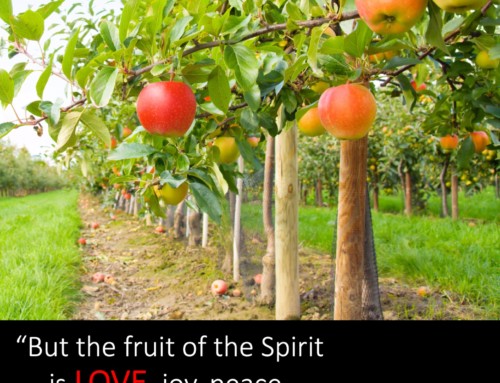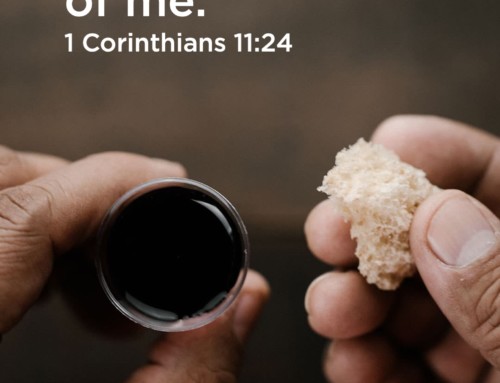Text: John 20:11-16
But Mary stood without at
When life is easy and things are going well from our vantage point, we generally have no problem recognizing the good hand of the Lord in our lives. Praise is automatic. But when life turns dark and difficult, sometimes we fail to realize that the Lord is still right there with us and still has His good hand upon us. The problem is that, if we don’t recognize Him in the darkness, we bring upon ourselves needless stress and anxiety. That was the case with Mary Magdalene at the garden tomb. Her story is a beautiful example from which we can learn personal lessons to help us better understand what God is doing in our lives even when we can’t see Him at work.
Background details
For Mary Magdalene, Jesus’ crucifixion was probably the most difficult, distressing event she had ever faced. She watched as wicked men dealt brutally with her Lord, the One who had saved her and delivered her from so much — even from “seven devils” (Mark 16:9). Since her conversion to Christ, Mary had become one of His devoted followers. The Bible tells us that she was devoted to Jesus throughout His three-year ministry right to the end. For example, John 19:25 tells us that she “stood by the cross of Jesus” along with His mother and Matthew 27:61 tells us that she followed Jesus’ body from Calvary to the tomb. There is no doubt that Mary’s appreciation of God’s grace in her life led to her evident devotion to Him.
Why she came to the tomb so early on the first day of the week, we do not know, but we are told that it was so early “it was yet dark.” The physical darkness was only a reflection of the dark emotion Mary was feeling, having witnessed such a horrific scene not 24 hours before. Her distress level must have been considerable; in fact, it possibly explains why she came to the tomb totally alone in the darkness, which would normally not have been wise for a woman to do. The disciples were not there because, we are told, they were afraid of the Jews (ch.20:19). So, for Mary to go alone to the tomb was a very dangerous thing to do.
Mary was obviously shocked to see the stone rolled away from the mouth of the tomb, because she immediately “ran” to Peter who came to the sepulchre with John, but when they saw the tomb empty, they “went away again unto their own home.”
But not Mary. She stayed at the tomb.
“But Mary stood without at the sepulchre weeping” (v.11) The sight of the empty tomb drained her of hope because the Lord was not there. Even the sight of two angels did not encourage her as they asked why she was weeping and her response was, “They have taken away my Lord, and I know not where they have laid him” (v.13). In other words, she didn’t know where the Lord was in this crisis. She couldn’t see him with her eyes, and so she concluded that He wasn’t there — someone must have taken him!
Have you ever wondered where the Lord is in your situation?
How often have you found yourself weeping unnecessarily as Mary did?
Mary wept because the situation before her seemed hopeless. Often that is our conclusion because:
- our circumstances do not make sense
- we cannot “see” the way ahead or understand a “logical” explanation for it
- we do not understand how the Lord could be in it
- we try to interpret things ourselves
- we approach the crisis with limited ability and lean on our own understanding
Let’s face it. Like Mary at the tomb, we often come to wrong conclusions. We forget that we are finite creatures with great limitations in our ability to understand our circumstances. We weep quietly alone; we cry to God, but we don’t see Him in the pain or the sorrow we are suffering because it’s still dark. We look for Him, but we do not find Him. So we despair. We take our grief upon ourselves and forget that the One who loved us and gave Himself for us “has borne our grief and carried our sorrows.”
Mary came to a wrong conclusion, “They have taken away my Lord.”
Women and wrong conclusions
We have to admit, that our female emotions can and do bring us sometimes to wrong conclusions. Emotions — as someone has said — often “play tricks on us.” We think we can explain why our painful circumstances are happening to us, and often we discover later, to our shame and disappointment, that we were totally wrong.
Mary was so convinced that Jesus’ body had been stolen that when she turned around and “saw Jesus standing” she didn’t even recognize Him (she “knew not that it was Jesus” v.14). She mistook Him for the gardener. She couldn’t have been further from the truth.
Mary knew not that it was Jesus (v.14)
Jesus was by her side all the time and she didn’t recognize Him. He looked like a gardener. What is a gardener? A human agent. In the dark, she “supposed” that the Man right there with her was just the cemetery gardener. She “supposed” that the reason for the empty grave was because her Lord was stolen by people. What’s the message here? Mary judged the situation on a human level.
Lesson for us:
Do we interpret our present difficulty on a merely human level? When difficulty comes, do we judge the “empty tomb” to be something painful and mistake the Lord for a gardener? How wrong we are sometimes!
If Mary had only realized! That empty tomb was the most incredible miracle of all history! What looked disastrous was actually the greatest blessing in not only her life, but in the lives of every Christian who has ever lived and ever will live! Jesus had risen from the dead and the Man standing in front of her was the very Lord Himself.
What a lesson for us! As we read this Biblical account, we can’t help but shout, “Look, Mary! Open your eyes! It’s the Lord, not a man! Jesus is right there with you! Don’t cry! It’s an enormous blessing in disguise! Jesus is risen!
Jesus’ tender reaction to Mary
Probably one of the most — if not the most tender address by the Lord to anyone in the whole of His ministry is found in the Lord’s response to Mary’s distress.
“Jesus saith unto her, Mary.”
Jesus just spoke her name, but what meaning in that one word! It made all the difference in Mary’s sorrow just to hear the voice of her Lord. All fear vanished. In that one word, everything now made sense. It was personal, tender, powerful, all-comforting.
Like the “footprints” poem, based on Hebrews 13:5 “I will never leave thee, nor forsake thee”, the Lord is ALWAYS with us, even though the darkness may hide His lovely face from our view temporarily. We must NEVER give up believing that He is with us even in the darkest hour. If Mary had known that her darkness was actually the most glorious light that could be imagined, how different her countenance and spirit would have been! The same is true for us. The Lord is working all things in our lives for our good and His glory. We must not allow the “shadow” of the present to frighten us. Shadows are not real —they are imaginary. Mary’s imagination caused her to “suppose”, but her “supposing” proved wrong.
What is your dark circumstance today? Is it an illness? Is it a bereavement? Maybe it’s an ongoing struggle that is bringing confusion and sorrow into your otherwise happy life. So many events can tempt us to turn our eyes away from the Master. May we be renewed in our minds to turn our eyes upon Jesus and look full in His wonderful face!
Turn Your Eyes Upon Jesus by Helen Lemmel, 192
O soul, are you weary and troubled?
No light in the darkness you see?
There’s light for a look at the Savior,
And life more abundant and free!
Refrain:
Turn your eyes upon Jesus,
Look full in His wonderful face,
And the things of earth will grow strangely dim,
In the light of His glory and grace.
Through death into life everlasting
He passed, and we follow Him there;
O’er us sin no more hath dominion—
For more than conqu’rors we are!
His Word shall not fail you—He promised;
Believe Him, and all will be well:
Then go to a world that is dying,
His perfect salvation to tell!
Brief Bio
Helen was born in England in 1863 and her father was a Methodist minister. When she was 12, the family emigrated to America, first leaving in Mississippi and then in Wisconsin. Helen became an excellent singer, studying vocal music in Germany before marrying a European. Subsequently, she taught music in Moody Bible Institute. Some years later she became blind, and sadly, her husband left her. She wrote over 500 hymns, wrote a well-known book for children “The Story of the Bible”, and continued with her music and writing until her death in 1961, just 13 days before her 98th birthday.
Helen wrote “Turn Your Eyes Upon Jesus” in 1922 when she was 59. It was based on the words of a tract called “Focused” by a missionary friend Lilias Trotter. It contained a statement that had a profound impact on her. Lilias Trotter was a brilliant artist whose talent opened the doors to wealth and influence. Her other love was missions. After struggling in prayer for two years, Trotter came to the conclusion that she must lay down her love of art in order to fix her eyes solely on Jesus, and on His calling to the mission field. She subsequently served for more than 38 years as a missionary to Muslims of Algeria. She also authored several books and tracts. The following is an excerpt from her tract, Which Passion Will Prevail? Lilias Trotter said:
“Never has it been so easy to live in half a dozen harmless worlds at once — art, music, social science, games, motoring, the following of some profession, and so on. And between them we run the risk of drifting about, the good hiding the best.” It is easy to find out whether our lives are focused, and if so, where the focus lies. Where do our thoughts settle when consciousness comes back in the morning? Where do they swing back when the pressure is off during the day? Dare to have it out with God, and ask Him to show you whether or not all is focused on Christ and His Glory. Turn your soul’s vision to Jesus, and look and look at Him, and a strange dimness will come over all that is apart from Him.”












